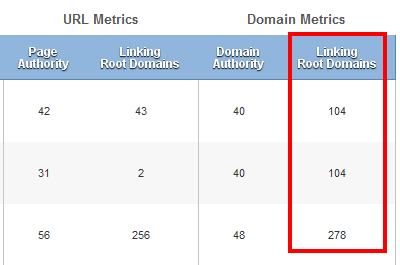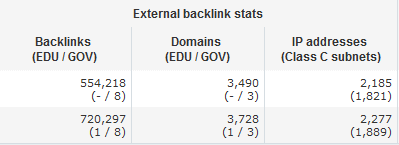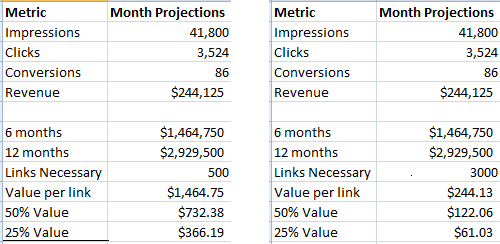How much is it going to cost to rank for the money keywords? That is the Holy Grail question any SEO practitioner struggles to answer whenever undertaking a new project. I am not going to touch on the buying links debate; however, I am going to show how to put a value on acquiring links to make your link acquisition efforts more of a data driven decision then a moment's whim decision.
Traffic Projections
Your first step is to determine traffic for a core set of keywords; I recommend picking 10 - 20 keyword categories that represent the short tail of your market. All your long tail keyword efforts will be extensions of the core set of keywords. You should also break your projections into a phase 1 & phase 2 with the first phase based on exact searches for the main top keyword of each category and the second phase focused on the top 10-20 keywords in each keyword category.
Competitive Analysis
Next you need to look at the number of unique root domain links the first page of results has for each keyword category. Pick the 10 keywords that have solid search volume and are known to convert into sales. Put each keyword into the SEOmoz keyword difficulty tool and export the results into excel. Average the root domains column for the first 10 results.

It is also a really good idea to run each site through Majestic SEO and note the unique IP address links in a column next to the SEOmoz numbers for a second opinion.

Print out a sheet for each keyword (10 print outs), spread them out on a table next to each other and make an educated estimate of the number of links to rank. I usually base this on the approximate number of root links I see for the third result because my goal is the top 3. Once in the top 3 you have a better idea of what is necessary to challenge the #1 spot and reach SEO heaven.
Revenue Projections
You need two key pieces of information to project revenue from search traffic; conversion rate and average revenue per sale. If your client or CEO cannot tell you these numbers; then run a PPC campaign to find out before investing in SEO. You do not want to spend 6-12 months optimizing for keywords that don't convert into sales.
Add a column to your traffic spreadsheet for conversion rate and another for revenue per conversion. I highly recommend using different conversion rates & revenue numbers for each keyword when you have data to back it up.

Calculating Value
At this point you should have traffic projections, conversion rates and average revenue for each keyword plus an estimate of the links necessary to rank. To keep things simple I add up the traffic, conversion and revenue numbers. I make the assumption it will take 6 months to reach the phase 1 numbers and an additional 12 months to reach the phase 2 numbers. Multiply the phase 1 revenue number by 6 to get an estimate of revenue generated in the first year. You most likely will generate revenue before the 6 month mark but creating a forecast model merits its own post. Now it is time to sit down with the client or your boss to have a candid discussion of when SEO costs need to break even and start providing a positive ROI. Let's assume 1 year; which means your 6 month revenue projection needs to cover all costs for the 12 months. To keep you from overspending cut your revenue number in half and use that as your SEO budget. I recommend dedicating 50% of the budget towards your link acquisition efforts with the other 50% for content, development, tools & salary.
Take the link budget you just established and divide it by the number of links you determined are necessary for a top 3 ranking. Now you have a dollar amount associated to the value of each unique link. If your site already has links you can subtract those from the estimated links number which will increase the value of each unique link you need to acquire.

Final Thoughts
Let me be clear that I DO NOT endorse buying links or anything else that would get your site banned from the search engines. I have found this is a great way to get budget approval & sell the value of link building for people who make data driven decisions.
Obviously the above model does not take into account that links from some domains are worth more than others from an SEO point of view. In a way that is good though because it takes away the emotional decision of getting a link from any particular site.
